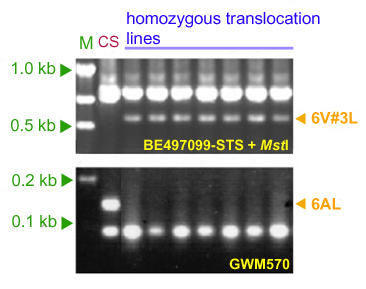Stem rust resistance gene Sr52 was transferred into wheat from the wild diploid relative Dasypyrum villosum. A set of whole arm Robertsonian translocations involving chromosomes 6A of wheat and 6V.3 of D. villosum was produced through centric breakage-fusion (1). D. villosum has been used before as a valuable source of genes transferred to wheat, including the powdery mildew resistance gene Pm21 as a T6AL.6VS translocation (2) and wheat spindle streak mosaic virus resistance gene Wss1, as a T4DL.4VS translocation (3).
Sr52 was mapped to the long chromosome arm 6V.3L of D. villosum, and when it was transferred to wheat it translocated with chromosome arm 6AL. Sr52 shows a temperature-sensitive resistance pattern to stem rust race Ug99 (TTKSK): it is most effective at 16°C, partially effective at 24°C and ineffective at 28°C. This variation of resistance with temperature could hinder affect field deployment, since the fungal pathogen is more active at warmer temperatures. Another factor to consider when using this gene for breeding programs was reported by Qi et al. (1). These authors observed that disomic wheat addition line carrying an extra D. villosum6V.3 chromosome was more resistant than three independent long arm translocation lines involving that chromosome, suggesting that there could be one or more minor resistance loci on wheat chromosome arm 6AL or an unknown interaction between D. villosum and Triticum aestivum genes.
Markers for Sr52
Due to the current lack of codominants markers, two dominant markers specific for each chromosome arm must be used to analyze recombinant lines. Microsatellite marker WMS570 amplifies an small fragment of between 100 and 200 bp in lines containing an intact 6AL. On the other hand, PCR amplification of STS marker BE497099-STS and treatment with restriction enzyme MspI yields an specific fragment for chromosome arm 6V.3L (1).
Primers for BE497099-STS
BE497099-STS-F 5'- TTC GCT CCA CCA GGA GTC TA -3'
BE497099-STS-R 5'- GTG TCT CGC CAT GGA AGG -3'
Annealing temperature: 60°C
Primers for WMS570
WMS570-F 5'- TCG CCT TTT ACA GTC GGC -3'
WMS570-R 5'- ATG GGT AGC TGA GAG CCA AA -3'
Amplification conditions
- 3 min at 94°:C
- 45 cycles of
- 1 min at 94°C
- 1 min at 60°C
- 2 min at 72°C
- 10 min at 72°C
Expected products

References
1. A novel Robertsonian translocation event leads to transfer of a stem rust resistance gene (Sr52) effective against race Ug99 from Dasypyrum villosum into bread wheat Qi LL, Pumphrey MO, Friebe B, Zhang P, Qian C, Bowden RL, Rouse MN, Jin Y, Gill BS. In: Theoretical and Applied Genetics, 2011, 123:159-167. DOI:10.1007/s00122-011-1574-z
2. Development and molecular cytogenetic analysis of wheat-Haynaldia villosa 6VS/6AL translocation lines specifying resistance to powdery mildew. Chen PD, Qi LL, Zhou B, Zhang SZ, Liu DJ. In: Theoretical and Applied Genetics, 1995, 91:1125-1128. DOI:10.1007/BF00223930
3. Development and characterization of a Triticum aestivum-Haynaldia villosa translocation line T4VS-4DL conferring resistance to wheat spindle streak mosaic virus. Zhang Q, Li Q, Wang X, Wang H, Lang S, Wang Y, Wang S, Chen P, Liu D. In:Euphytica, 2005, 145:317-320. DOI:10.1007/s10681-005-1743-8
